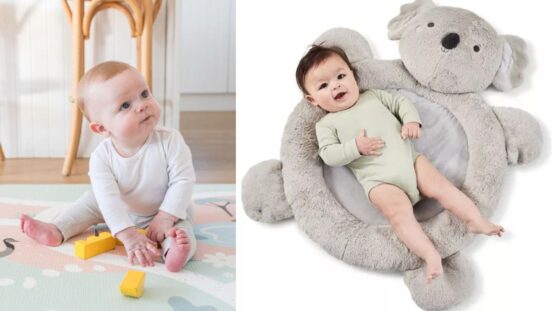7 week old: How to soothe skin issues
Has your baby developed cradle cap or nappy rash? Plus, what else is happening for your 7-week-old...
Skin issues, overstimulation and baby massage
Baby skin issues
In the first three months, around half of all babies develop cradle cap. It loks like dry, yellow crusty, flakes on yur baby's scalp. Cradle cap is a result of overstimulating bub's oil producing glands, which leads to skin flaked becoming trapped that cakes on the skin.
In most cases cradle cap clears up on its own but you can help by combing or brushing her head (even if she has no hair), which can help stimulate the oil glands in her scalp to heal the dry patches.
If it looks like it's getting worse, speak to your health professional.
Some babies also get nappy rash. It appears as small red dots on your baby's bottom, with an inflamed area of broken skin or even pus-filled spots in more serious cases.
Breastfed babies are less prone to nappy rash, which can occur if a wet or dirty nappy is left on for too long. But some babies suffer regardless of frequent changes.
The bacteria from your baby's stool breaks down the urine to ammonia, which irritates and burns the skin. Loose bowel motions, which often occur when your baby is ill, can have this effect after just one nappy.
The following may help:
• Start using nappy rash cream at the first sign of broken skin.
• Be aware of nappy preparations, like wipes or moisturiser, that aggravate the condition.
• After your baby has had nappy rash, it's important to allow her skin to be aired between changes for up to 20 minutes.
• In severe or persistent cases, seek your doctor's advice.

"I'm overstimulated!"
Your seven-week-old loves attention, but can become overwhelmed by too much stimulation, particularly if she's being surrounded by lots of people or rushed from one place to the next.
If this happens, schedule in some quiet time to allow your baby to calm down. Reduce the amount of stimulations she's exposed to by taking her to a quiet room.
Turn off the TV and radio and keep other distractions and noise to a minimum.
Calmly stroke her forehead, gradually slowing the strokes. Try to match the rhythm of your breathing to here while you stroke.
Gentle massage might also help.
Baby massage
When your little one is massaged, her body releases endorphins that help her wind down before she sleeps, especially if massage is a regular part of her routine.
Also, studies show new mums with mild postnatal depression feel better when they give their baby a massage. It boosts circulation, encourages bonding and is also a good way for dads to get involved with their baby.
Here's how to do it:
• Make sure the room is warm enough. Remove any jewellery from your fingers and wrists.
• Lay your baby on a thick towel, then pour some oil onto your hands, not onto your baby. Try using a vegetable-based oil, such as grapeseed oil, or one recommended for babies.
• Use only gentle stroking movements when massaging your baby. The movements should be smooth and rhythmical, but firm and even at the same time.
• Using the tips of your fingers, stroke your baby's abdomen in a clockwise direction, passing one hand over the other to keep the stroke continuous.




